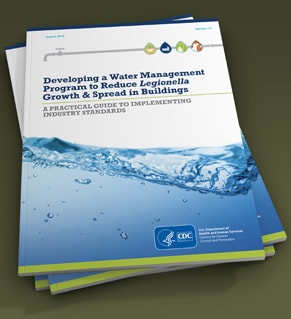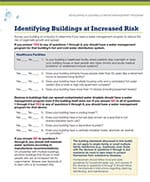Toolkit: Developing a Water Management Program to Reduce Legionella Growth and Spread in Buildings
A Practical Guide to Implementing Industry Standards
Many buildings need a water management program to reduce the risk for Legionella growing and spreading within their water system and devices. This toolkit is designed to help people understand which buildings and devices need a Legionella water management program to reduce the risk for Legionnaires’ disease, the key elements of a water management program, and how to develop it.
Use the toolkit’s quick yes/no worksheet to find out if your building or certain devices in your building need a water management program.
Provide Feedback
CDC welcomes feedback on this toolkit. Email RDB@cdc.gov with your thoughts and suggestions.
Background
Legionella bacteria are typically found naturally in freshwater environments, but can become a health concern when they grow and spread in human-made water systems. Legionella can cause a serious type of pneumonia (lung infection) known as Legionnaires’ disease. Some water systems in buildings have a higher risk for Legionella growth and spread than others. Legionella water management programs are now an industry standard for many buildings in the United States (ASHRAE Standard 188: Legionellosis: Risk Management for Building Water Systems January 2018. ASHRAE: Atlanta).
Scope of the Toolkit
This toolkit aims to provide an easy-to-understand interpretation of ASHRAE Standard 188 to help building owners and managers. They can use the toolkit to help evaluate their water system and devices in their building(s) to determine if they need a program. Then the toolkit explores how to develop an effective water management program if one is needed.
The toolkit includes:
- A simple yes/no worksheet to determine if an entire building or parts of it are at increased risk for growing and spreading Legionella
- A basic review of the elements of a Legionella water management program
- Scenarios describing common water quality problems and examples of how to respond to them to reduce the risk for Legionella
- Special sections and considerations for those who work in healthcare facilities
- CDC’s Toolkit for Controlling Legionella in Common Sources of Exposure
- Worksheet to Identify Buildings at Increased Risk for Legionella Growth and Spread
- Preventing Legionnaires’ Disease: A Training on Legionella Water Management Programs
- Legionella Environmental Assessment Form
- Legionella Environmental Assessment Form Marking Guide
- Water Management Gaps and Legionnaires’ Disease Outbreaks
- ASHRAE Standard 188: Legionellosis: Risk Management for Building Water Systems (ANSI approved)
- Frequently Asked Questions: ASHRAE Standard 188
This webpage answers frequently asked questions about ASHRAE Standard 188, which outlines a legionellosis risk management program for buildings. - ASHRAE Guideline 12-2020: Managing the Risk of Legionellosis Associated with Building Water Systems
- Read-only versions of ASHRAE Standards and Guidelines
- Centers for Medicare & Medicaid Services Requirement to Reduce Legionella Risk in Healthcare Facility Water Systems

